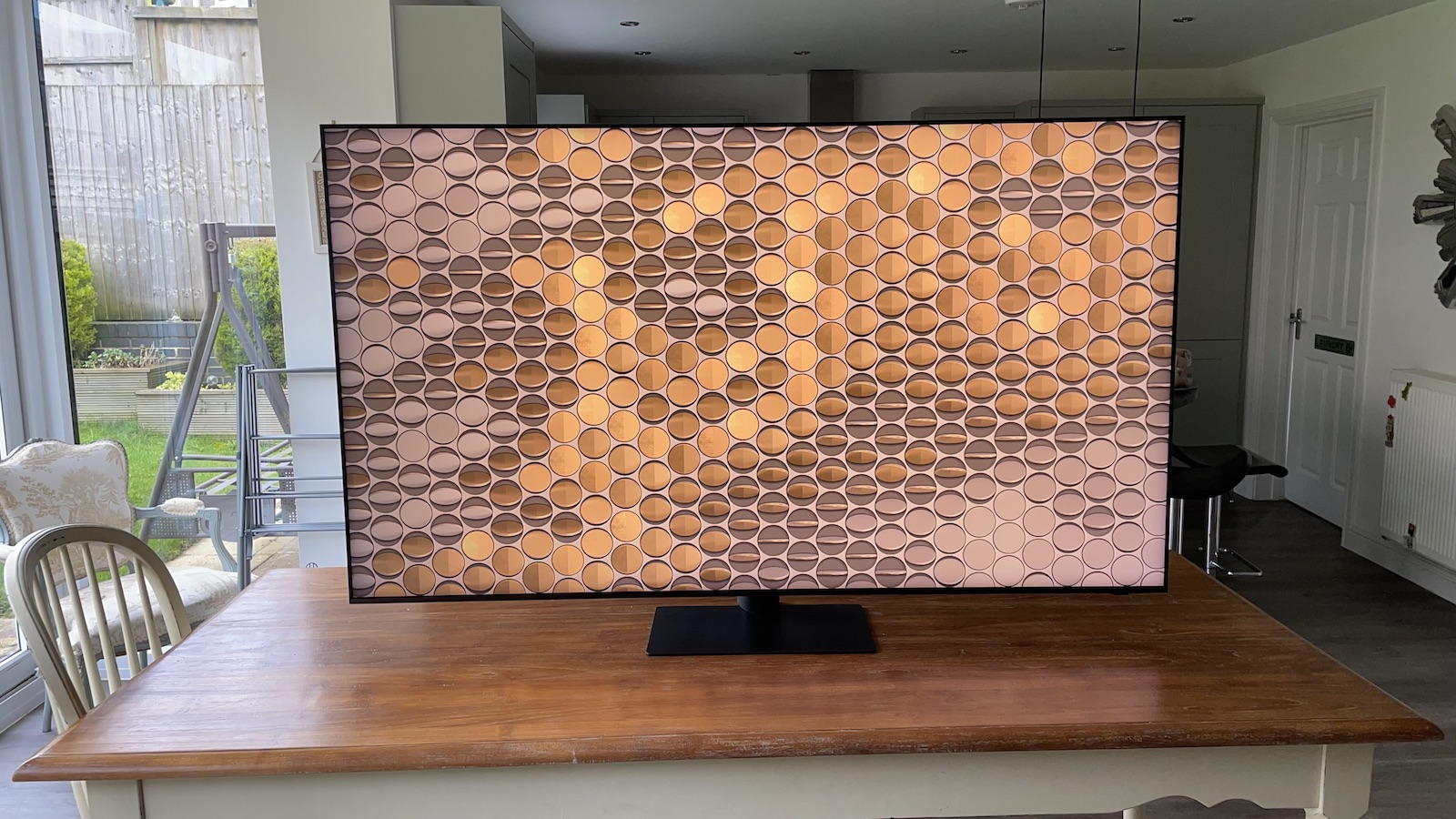
There was a time when a manufacturer producing similarly priced OLED and LCD TVs in a range made perfect sense. You had the LCDs for bright room setups, and the OLEDs for dark-room home cinema groupies. Plus there used to be concerns about OLED screen burn if you tried to drive them anywhere near as bright as LCD TVs could go.
Now that OLEDs are finding ways to get brighter without seemingly increasing their susceptibility to screen burn, is the TV landscape changing? Or, to be more specific, is there still a space in the market for premium LCD TVs?
No TV should be better placed to tell us this than Samsung’s flagship 65-inch 4K LCD TV for 2024, the QN95D QLED. Especially as Samsung is this year following a ‘dual premium’ approach where it’s saying its premium 4K Mini LED and QD OLED TVs are essentially on the same level as each other.
We’ve had the chance to spend a few days with an early (and slightly buggy) 65-inch sample of the QN95D, and here are our thoughts so far.
Price
At £3699 in the UK (US and Australian pricing has yet to be confirmed), the 65-inch QN95D is priced exactly in line with its 2023 QN95C predecessor. While this certainly marks it out as a high-end offering by 65-inch LCD TV standards, it should also probably be classed as a decent result given how much inflation the world has seen over the past 12 months.
The 65-inch S95D, by comparison, is launching at £3599, which suggests that there’s still a small feeling in Samsung’s heart that the QN95D is the slightly more premium option of the two.
Design
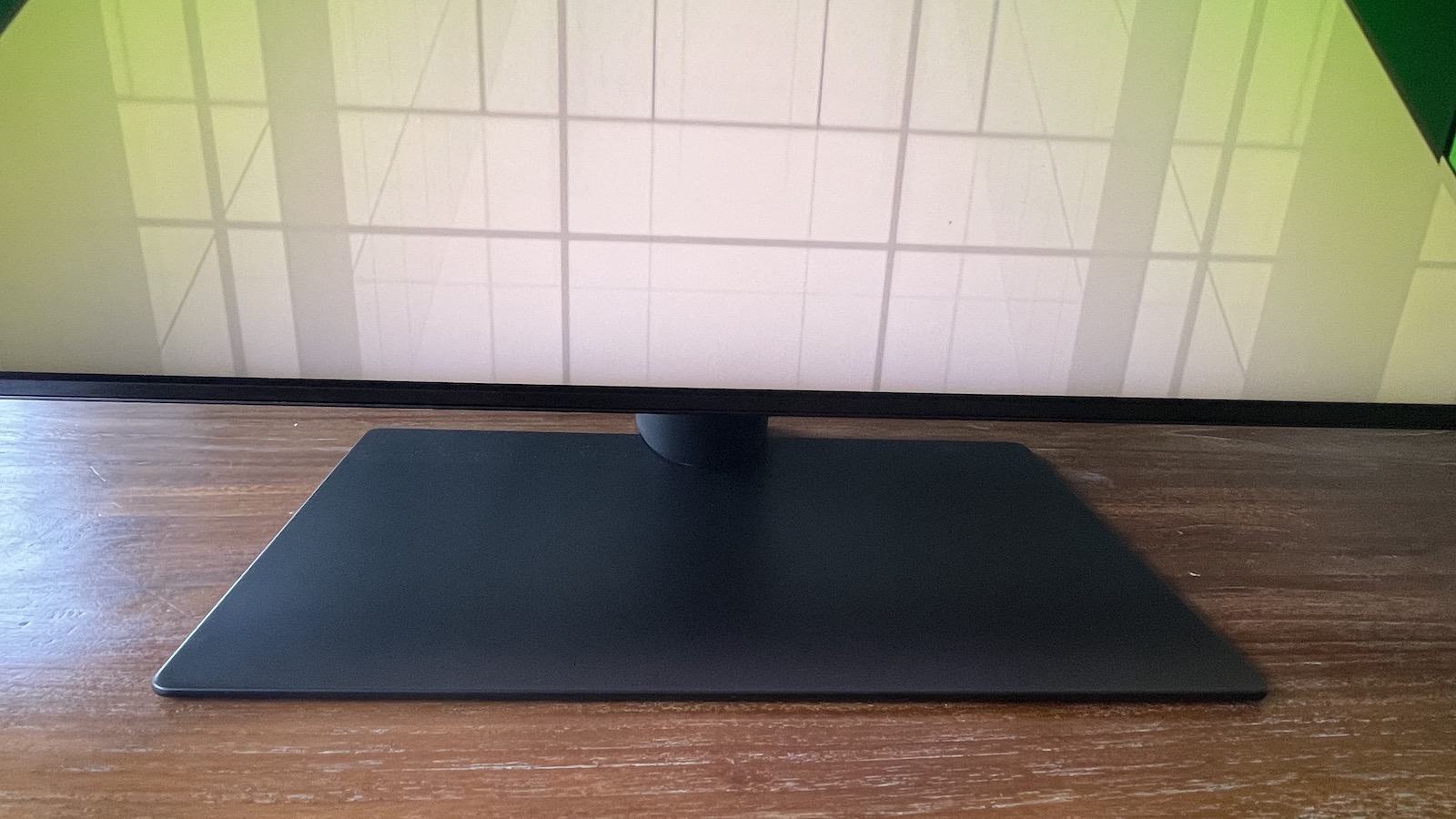
The QN95D isn’t as glamorous and futuristic-looking as the S95D QD-OLED or the recently reviewed QN900D 8K TV. It’s less ultra-slim around the back, and its dark grey metallic finish is a bit less attention-grabbing.
That doesn’t mean its so-called Infinity One design isn’t still pretty attractive, though. Its build quality is robust, the metallic finish still feels premium, and it’s still actually fairly trim around the back by LED TV standards. It also enjoys one of Samsung’s distinctive flat-at-the-back, flat-at-the-front monolithic profiles, and sits on a compact, centrally attached plate-style stand, so you don’t need to find a wide piece of furniture to put it on.
As with its rear panel, while the QN95D’s bezel is a touch wider than the one wrapped around the QN900D, it’s still very slim by 65-inch TV standards.
Included in the QN95D’s onscreen menus is an Ambient mode that lets you fill the screen with a variety of downloadable photographs, stylish designs, artworks, video loops (some accompanied by soothing music or nature sounds) or even your own digital snaps. Handy if you don’t want the TV to become a big black hole in your decor when you’re not watching it.
The QN95D ships with two remote controls. One is a standard one, complete with lots of buttons, while the other is a stripped-back smart remote, with far fewer buttons, a sleeker design and a solar panel on its rear. Both are effective enough, though we would love Samsung to include a direct input select button on the smart remote.
Features
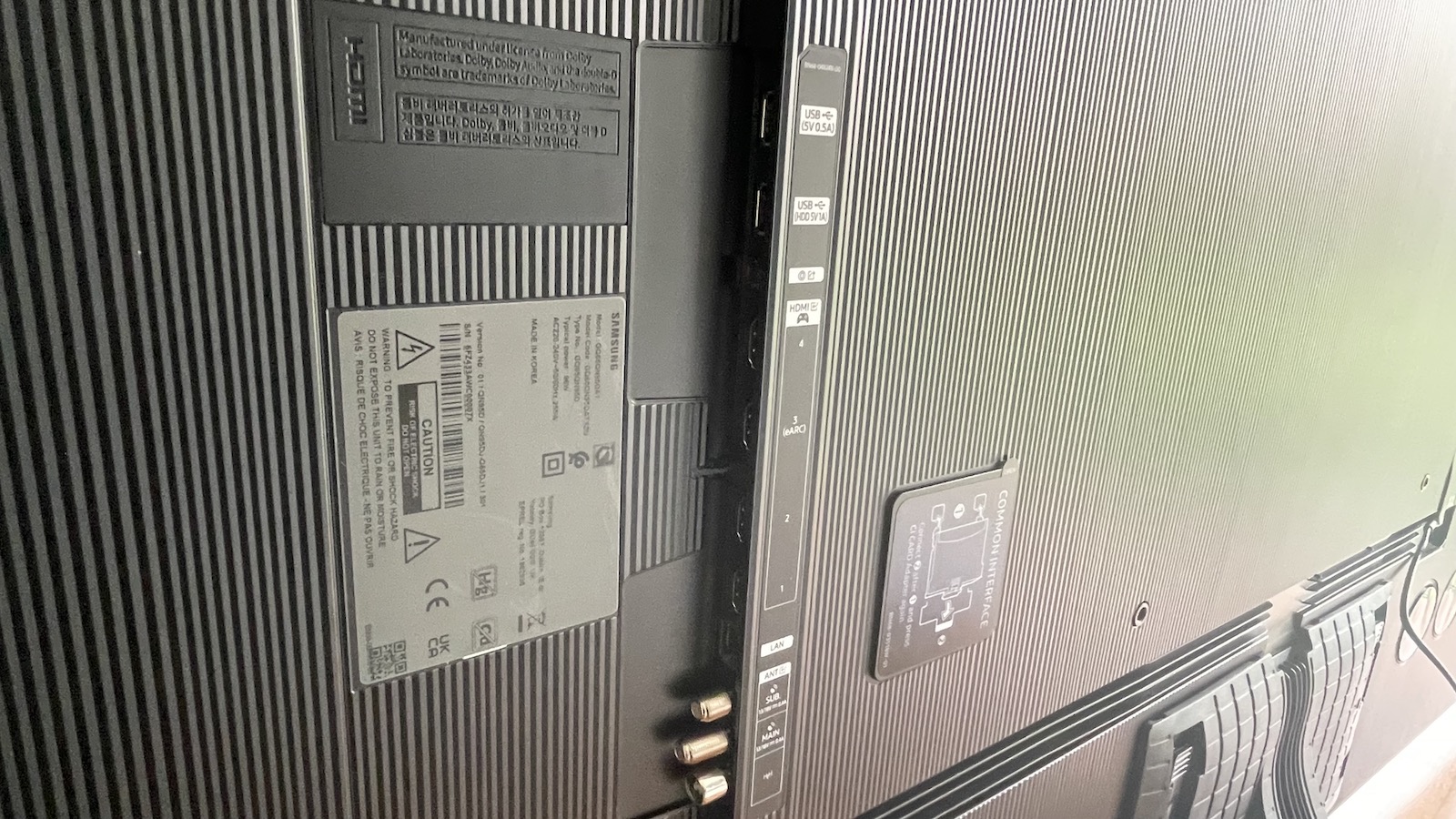
The QN95D is a 4K TV that uses Mini LED backlighting behind a VA type of LCD panel. VA panels usually deliver better contrast but narrower viewing angles than the rival IPS type of panel, but the QN95D is equipped with Samsung’s wide-angle technology and so will hopefully deliver the contrast benefits without the viewing angle limitations.
The Mini LED lighting sees the picture illuminated by LEDs a fortieth the size of regular ones, raising the potential for much more refined light control. Refinement is enhanced on the QN95D by an advanced local dimming system that in the case of the 65-inch model uses an impressive 1344 separately controllable zones.
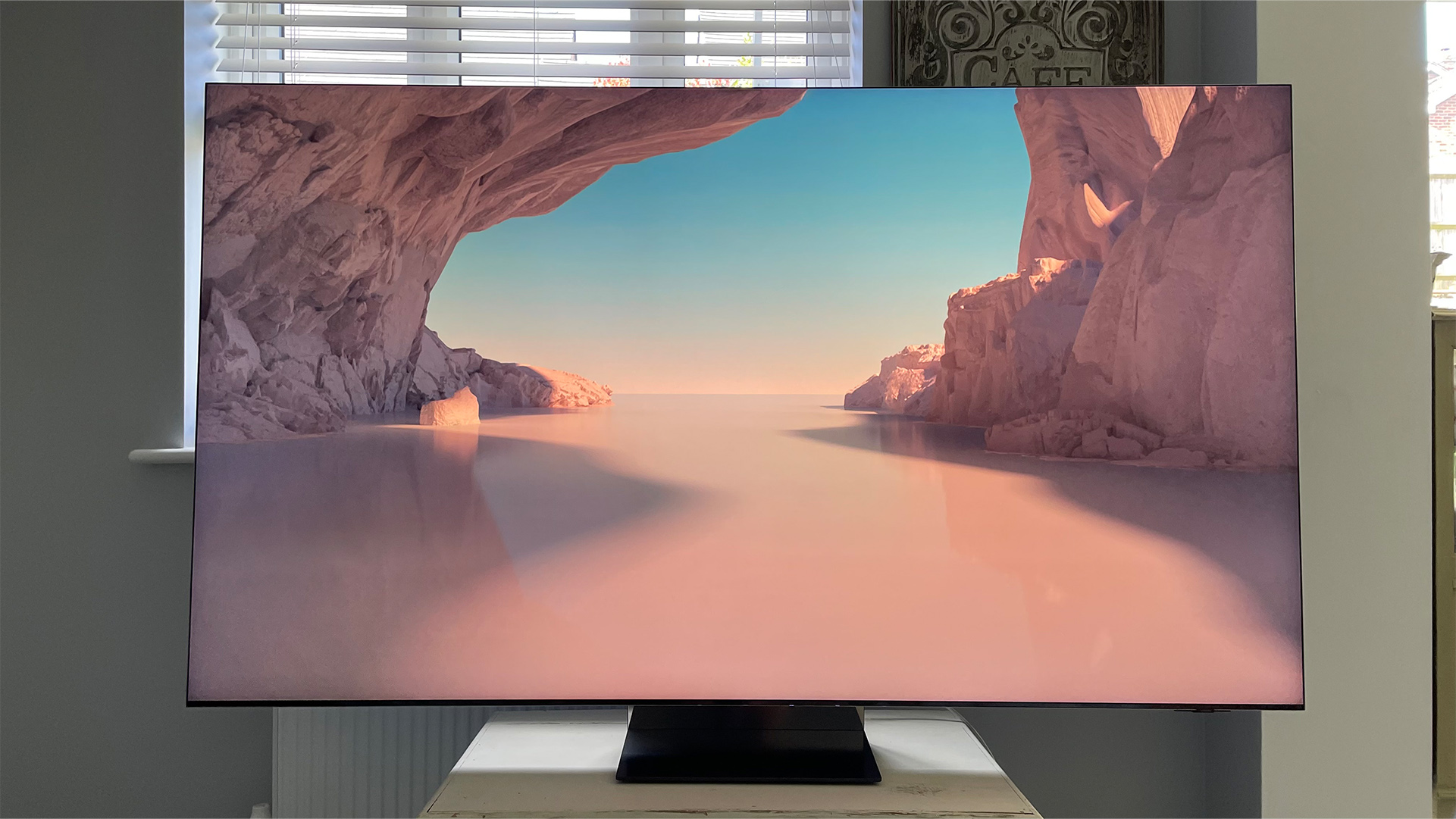
Screen size 65 inches (also available in 75in, 85in)
Type QLED
Backlight Mini LED
Resolution 4K
HDR formats HLG, HDR10, HDR10+
Operating system Tizen
HDMI inputs x 4 (4 x 48Gbps HDMI 2.1)
Gaming features 4K/120Hz, VRR, ALLM
Input lag 9.8ms (60Hz)
ARC/eARC eARC
Optical output? Yes
Dimensions (hwd, without stand) 83 x 145 x 2cm
There’s a new Neo Quantum 4K AI Gen 2 processor to drive this local dimming system, too. Bolstered by the combined know-how of 20 separate neural networks, this processor also promises improved 4K upscaling of sub-4K content, better power management and a new Real Depth Enhancer Pro system that detects the main subjects of any given image and subtly emphasises them to create a more three-dimensional effect that resembles the way we perceive the real world.
It even marks the return to Samsung TVs of Auto HDR remastering, where the TV attempts to convert SDR content to HDR. This works much more subtly and effectively than Samsung’s previous efforts, though is still something that we generally prefer to leave switched off.
The QN95D’s Quantum Dot colour system is claimed to deliver 100% of the DCI-P3 HDR colour range, while supported HDR formats extend to HDR10, HLG and HDR10+. As ever with Samsung TVs there’s no support for the Dolby Vision HDR format that HDR10+ was essentially designed by Samsung to rival.
Gamers are very well served by the QN95D. All four HDMIs can take in 4K/120Hz signals (actually 144Hz if you have a sufficiently capable PC) and VRR using the HDMI and AMD Freesync Premium Pro formats. There’s ALLM support for automatic Game mode switching, and in that mode, input lag drops to a spectacularly low 9.8ms, though there are options to increase this lag figure slightly in return for different levels of motion smoothing.
A dedicated Game Hub screen puts all your game sources, be they streamed or connected to the HDMIs, in one place in the QN95D’s smart menus, and a Game Bar menu you can call up when gaming that gives you access to information on your gaming feed and a series of gaming aids such as an onscreen crosshair, a dark area brightness booster, and a mini-map zoom feature. The screen even supports the super ultra-wide game view aspect ratios some PC games provide.
Smart features are provided by Samsung’s Tizen OS. This is rich in content, to say the least, providing every streaming app the vast majority of TV viewers will ever want, as well as a multitude of ways to find and watch content.
Today’s Tizen can actually feel a bit too complicated initially, though you do start to find your way around it with a bit of practice. Plus, Samsung has helped this year by placing a simple row of app icons in the top half of the home screen now, as well as introducing a new ‘For You’ tab that provides a mixture of direct access back to broadcast or streamed shows where you last watched them, and recommendations from a wide range of sources based on your viewing habits.
There’s built-in voice control, finally, via either Samsung’s own Bixby system or Amazon Alexa.
Picture
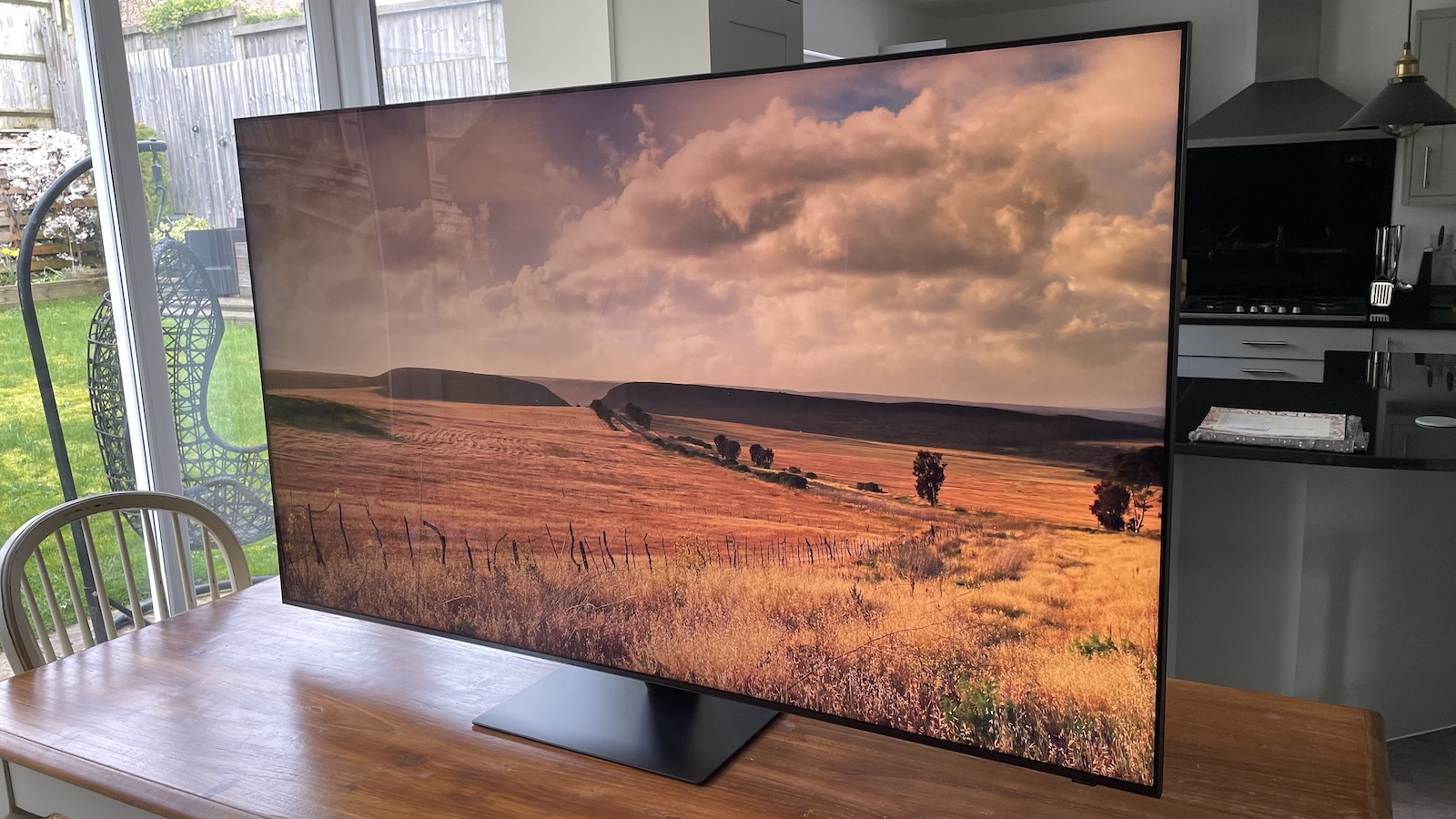
Our impressions of the QN95D so far are positive – with a couple of caveats.
The biggest but also in a way smallest of these caveats is that the early sample we’ve been looking at is rather buggy. The backlight doesn’t seem to respond quite right to changes in the brightness of different HDR scenes, leaving dark scenes looking too bright. Unless, that is, you pause the bright scene and then hit the picture settings reset button, at which point the dark scene suddenly looks as it should. It then stays that way for a while, before the issue creeps back in.
Samsung assures us that this issue is unique to our pre-production sample and isn't present on final production TVs, and we have no reason to doubt that. And, thankfully, once sorted, this issue stays fixed for long enough to enable us to form some thoughts on how a fully functioning QN95D will likely shape up. And the news is mostly very good.
Black levels, for instance, are excellent by LCD standards. Spectacular even, with hardly any sign of tell-tale low-contrast greyness. Also, when using the punchy Standard picture preset, there’s remarkably little sign of any blooming or clouding during dark scenes, even where a very bright object appears against a dark backdrop.
Despite the excellent black levels, brightness levels are impressive – noticeably up, at least in the Movie and Filmmaker Mode presets, on those of the QN95D’s 2023 QN95C predecessor. This means it also pushes gently in those presets into brightness territory with reasonably large bright areas and, especially, full-screen bright images beyond anything even the latest OLED TVs can do.
Colours are as intense as we’ve come to expect from premium Samsung ‘QLED’ TVs while also retaining impressive blend subtlety and skin tone naturalism. This colour subtlety contributes to an excellent sense of depth, enhanced as promised by the Real Depth Enhancer, as well as helping the picture look extremely detailed and crisp.
The QN95C’s sharpness is superb even by Samsung’s usually dependable standards, making native 4K look if anything slightly better than 4K. The excellent new upscaler, meanwhile, converts HD to 4K with a beguiling combination of sharpness, genuinely organic-looking extra detail and texture, and an outstanding appreciation for the difference between noise and real picture information.
Viewing angles before the picture starts to lose contrast or colour are much wider than usual with VA LCD panels, and provided you set the Picture Clarity option to Custom and adjust the judder and blur settings to level three or four, motion looks clean and sharp without the image starting to look processed or over-smoothed.
We did notice one or two issues beyond the backlight bug, though. As with the QN900D, in Standard mode, the backlighting can be so obsessed with trying to avoid backlight blooming and clouding that it can dim bright objects a bit too aggressively when they appear against dark backdrops. There can also be some slightly distracting shifts in the image’s overall brightness during sharp cuts between dark and light images.
While the Movie mode fixes or, at least, greatly reduces these brightness inconsistencies, it can cause backlight blooming to become a bit more noticeable during dark scenes. And finally in the ‘food for thought’ column, the brightness boost over OLED is not as pronounced as it is with the recently reviewed QN900D. So the 65QN95D doesn’t maintain the ‘LCD is bright enough to be better for light rooms than OLED’ argument as strongly as its 8K sibling.
There’s still some advantage with certain very bright content, but the latest OLED TVs actually deliver quite a bit more intensity with bright highlights in dark scenes than the QN95D does in its otherwise punchiest Standard mode, as those self-emissive OLEDs don’t have to compromise the look of bright highlights to avoid backlight blooming.
Uncertainties over when exactly our QN95D’s seemingly bugged backlight behaviour might be affecting the picture prevent us from yet forming a definitive view of its performance. But so far we’d say it looks very good while keeping one eye on what’s about to come out of Samsung’s new S95D flagship QD-OLED range.
Sound

First impressions of the QN95D’s sound suggest that while it falls prey to a couple of common Samsung limitations, it’s actually one of the brand’s better-sounding efforts.
The limitations find the sound lacking forward impact, which means the action often seems to be happening behind the screen, and maximum volume levels are a bit limited for a TV able to deliver such cinematic pictures. A touch of buzzing distortion can sneak in when the QN95D is playing particularly exposed high treble sounds, too.
The good news is that bass reaches deeper and makes more of an impact than it tends to with Samsung’s skinnier TV designs. It does so, too, without succumbing to distortions or dropouts. This extra pressure to the QN95D’s sound also means it’s capable of expanding and growing its sound better than many Samsung TVs, avoiding that sense of loud action or horror scenes suddenly collapsing in on themselves once they reach a certain crescendo level.
As usual, finally, Samsung’s Object Tracking Sound system is on good form with the QN95D, doing an excellent job of both creating quite a large soundstage that extends beyond the TV’s four edges with Dolby Atmos mixes, while simultaneously placing effects within that soundstage with striking accuracy. The system can even track multiple objects very effectively as they move around the screen.
Early verdict
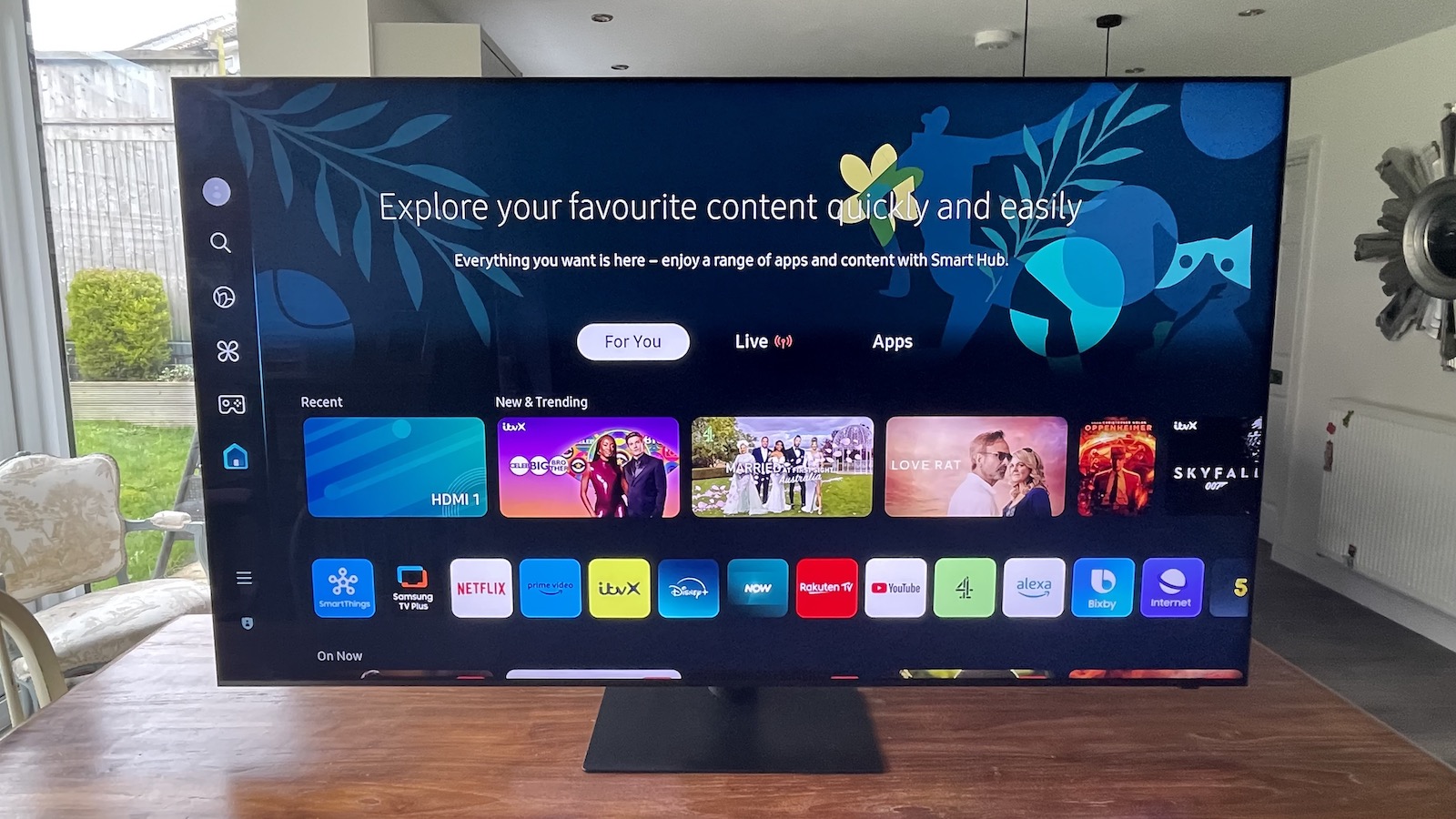
While the pre-production QN95D sample we’ve been looking at so far isn’t quite stable enough to give us a conclusive look at its talents, we’ve seen enough to know that it’s looking set to be another formidable Mini LED flagship 4K TV.
That said, it’s too early to say whether that’s still good enough to give it a powerful raison d’etre alongside Samsung’s imminent third-gen QD-OLED TVs.
We will of course update this page with a final, conclusive review once we have a fully working production sample.
MORE:
How about 8K? Here's our Samsung QN900D review
These are the best TVs you can buy right now
And here are the best TV deals






